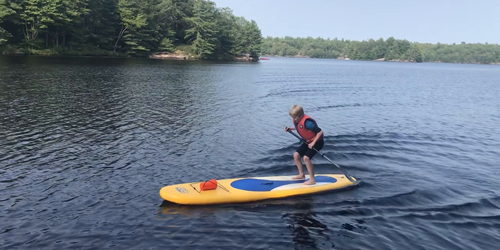“Gunwale Bobbing” Explained
If you find yourself up a creek without a paddle, bear in mind an alternative propulsion method: “gunwale bobbing.” This trick, in which a vessel is driven by bouncing up and down at one end, has long been known to paddleboarders and canoeists, but has received little attention from physicists. Now, Graham Benham at the University of Oxford, UK, and his colleagues have derived the first hydrodynamical model of the technique [1]. They say that their model could help to optimize the performance of competitive rowers.
Benham’s colleague, Jerome Neufeld of the University of Cambridge, UK, was inspired to investigate gunwale bobbing when on a lakeside vacation. He noticed that a paddleboard moving via this method resembled a droplet “walking” across the surface of a liquid, which can happen when the droplet interacts with self-generated waves (see Focus: Stop and Go Droplets). The team’s model shows that a vessel can also cross a body of water using waves created when its two ends pitch up and down. In a symmetric system, these waves cause the vessel to oscillate back and forth with no net motion. But in an asymmetric system, such as that created when a person imparts a vertical displacement, or a “heave,” out of phase with the pitch of one end of the vessel, the vehicle gains a net thrust.
Previously, researchers identified parallels between the walking droplets that inspired Benham and his colleagues and an early interpretation of quantum mechanics known as pilot-wave theory. Benham says he wonders whether those links also extend to gunwale bobbing. Exploring that idea will require a large quantity of experimental data, necessitating further lakeside vacations, he says.
–Marric Stephens
Marric Stephens is a Corresponding Editor for Physics Magazine based in Bristol, UK.
References
- G. P. Benham et al., “Gunwale bobbing,” Phys. Rev. Fluids 7, 074804 (2022).




